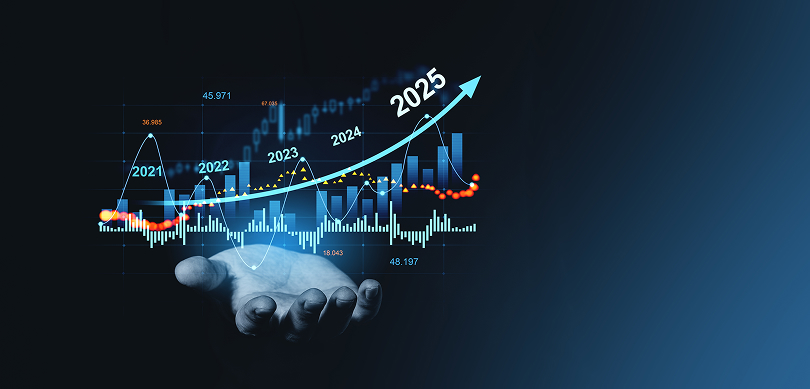- Last Updated: Apr 17,2024 |
- Religare Broking
Implied Volatility (IV) is a key metric that sheds light on market expectations and potential price movements. For an avid trader, it is not enough to use an implied volatility formula or Black Scholes formula for assessing stocks’ directional move. Rather it is imperative to understand what an IV is and know about types of IV, Percentile and Rank to harness the power of options effectively.
- What is Implied Volatility or IV?
- What is IV Percentile ?
- What is Implied Volatility Rank ?
- Difference Between Implied Volatility and Historical Volatility ?
- Implied Volatility as a Trading Tool
- Key Takeaway
Topics Covered :
What is Implied Volatility or IV?
Implied Volatility refers to the market's collective forecast of an asset's potential price fluctuations. It gauges the expected magnitude of price swings and plays a pivotal role in determining options' prices.
IV is not a fixed number, but rather a reflection of market sentiment and participants' perceptions of risk and uncertainty. When IV is high, it indicates that market participants anticipate significant price fluctuations in the asset. Conversely, low IV implies that the market expects relatively stable price movement.
For investors, IV is of particular importance due to the inherent volatility of the financial markets. It serves as a valuable tool for gauging how certain or uncertain market participants are about the future direction of an asset's price.
In essence, IV covers the collective wisdom of market participants, providing them with insights into potential market moves. By analyzing IV, investors can make more informed decisions, select appropriate options strategies and manage risk effectively in the dynamic landscape of options trading.
Recommended Read: What is Future & Options in Stock Market
What is IV Percentile
IV percentile is a measure that indicates where the current implied volatility level for an asset stands relative to its historical range. It is expressed as a percentage and helps traders understand whether the implied volatility is currently high or low compared to its recent history. Here's how you calculate IV percentile:
Collect historical implied volatility data for the asset, typically over a specified time frame, such as the past year.
Determine the current implied volatility for the asset.
Calculate the percentile rank of the current implied volatility within the historical range. This is typically done using statistical software or IV Calculator.
IV Percentile (%) = [(Number of Historical IV Data Points ≤ IV current) / Total Number of Historical Data Points] * 100
IV percentile can help traders identify potential trading opportunities. For example, if the IV percentile is very low (near 0), it suggests that implied volatility is currently at the lower end of its historical range, which may indicate a good time to consider buying options (especially strategies like long calls or long puts) since they may be relatively cheap. Conversely, a high IV percentile (near 100) suggests that implied volatility is at the higher end of its historical range, which may make selling options (e.g.,credit spreads) more attractive.
Read Also: Demat Account MeaningWhat is Implied Volatility Rank:
IV rank is a similar concept to IV percentile but is expressed as a numerical rank rather than a percentage. It provides a simpler way to gauge where current implied volatility stands within its historical range. The rank is usually calculated on a scale from 0 to 100, with 0 indicating the lowest implied volatility and 100 indicating the highest.
Here's how you calculate IV rank:Collect historical implied volatility data for the asset over a specified time frame.
Determine the current implied volatility for the asset.
Calculate the IV rank by comparing the current implied volatility to the historical implied volatilities. It's essentially the percentage of time that implied volatility has been lower than the current level over the specified historical period.
IV Rank is calculated as a percentage and is determined by comparing IV current to IVavg. The formula is as follows:
IV Rank (%) = [(IV current - IV min) / (IV max - IV min)] * 100
Both IV percentile and IV rank are valuable tools for options traders because they provide insight into the relative pricing of options. By considering these metrics along with other factors like market conditions, fundamental analysis, and technical analysis, traders can make more informed decisions when trading options and managing their risk.
Difference Between Implied Volatility and Historical Volatility
Implied Volatility and Historical Volatility (HV) differ in their nature and application. Historical Volatility is retrospective, measuring past price movements to determine the asset's historical variance. IV, on the other hand, is forward-looking and explores market expectations for future volatility.
IV responds to market sentiment and incorporates factors such as upcoming earnings announcements, geopolitical events and economic data releases. Historical Volatility however relies solely on the past price data.
HV can provide insights into how an asset behaved in the past, but IV offers a glimpse into potential future outcomes. Both are valuable tools for options traders, but they serve distinct purposes. The differences between Implied Volatility and Historical Volatility can be highlighted as:
Source of Data: is derived from options prices, capturing market expectations for future price movements. HV is calculated from historical price data, reflecting an asset's past price behavior.
Time Frame: IV pertains to the future and represents expectations for upcoming price volatility. HV focuses on the past and provides insights into an asset's historical volatility.
Application IV is vital for options pricing, strategy selection and risk management. It's used to assess whether options are overpriced or underpriced based on market expectations. HV is used for analyzing an asset's historical behavior and can help investors understand how volatile the asset has been in the past.
|
Aspect |
Implied Volatility |
Historical Volatility |
|
Definition |
Expected future price volatility |
Past price volatility |
|
Source |
Derived from option prices |
Calculated from historical price data |
|
Forward-looking |
Yes |
No |
|
Reflects Expectations |
Yes, market participants' future forecasts |
No, based on actual past price movements |
|
Used in Option Pricing |
Yes, a key input in option pricing models |
No |
|
Interpretation |
Market sentiment indicator |
Measure of price fluctuation in the past |
|
Calculation Method |
Derived from option pricing models |
Statistical calculation based on price data |
|
Timeframe |
Any time frame |
Historical period specified for calculation |
|
Sensitivity |
Can change rapidly due to market events |
Stable unless new data is added |
|
Volatility Clusters |
Can show patterns during market turmoil |
Can highlight historical market behavior |
|
Prediction Use |
Used to estimate potential future movement |
Used to analyze past price volatility |
Implied Volatility as a Trading Tool
Implied volatility (IV) is a crucial tool for options trading. It represents the market's expectation of how much an underlying asset's price will fluctuate in the future. More specifically, implied volatility is a key input in option pricing models, such as the Black-Scholes model, which help traders and investors determine the fair value of options.
Recommended Read: What is Spread Trading
Options Pricing:
Implied Volatility directly influences options pricing. Higher IV leads to higher options prices, and vice versa. It helps traders assess whether options are overpriced or underpriced.
Market Expectations:
IV indicates the market's outlook on potential price movements. A sudden surge in IV could imply an upcoming event that might impact the asset's value.
Comparative Analysis:
Traders can compare an asset's current IV with its historical IV to assess whether the market's expectations are unusually high or low.
Strategy Selection:
IV assists in strategy selection. High IV might prompt traders to consider strategies that benefit from price swings, while low IV might lead to strategies that capitalize on price stability.
Key Takeaway:
Understanding Implied Volatility and related terms such as IV Percentile and IV Rank, investors can assess market sentiment, make informed decisions, and tailor strategies according to their outlook on price volatility. By delving into these concepts, investors can elevate their options trading game and navigate the financial markets with greater precision and confidence.
Open a Free Demat Account and Explore the Markets with Ease!












